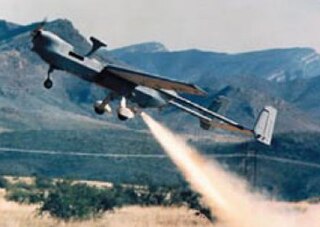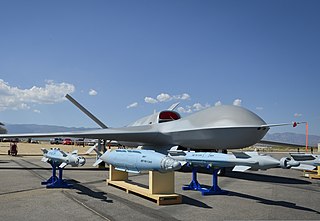See also
Aircraft of comparable role, configuration, and era
Related lists
| Sparrowhawk | |
|---|---|
| Role | Parasite Unmanned Aerial Vehicle |
| National origin | United States |
| Manufacturer | General Atomics Aeronautical Systems |
| Status | In development |
The General Atomics Sparrowhawk is an unmanned parasite aircraft currently being developed by General Atomics Aeronautical Systems (GA-ASI). First disclosed in 2019 and revealed to the public in September 2020, the Sparrowhawk is intended to offer the United States Air Force a Small Unmanned Aerial System (sUAS) capable of SIGINT/ELINT, ISR, radar imaging, jamming and the possibility for future roles. [1] [2]
The Sparrowhawk is derived from the General Atomic's submission to the DARPA Gremlins program, which aimed at developing small UAVs that could be deployed and recovered midair by a mothership aircraft. Chris Pehrson, the vide-president of strategic development for Department of Defense customers with General Atomics, stated in 2019 that the planned first flight of the UAV would be in 2020, with an sale to customers expected by 2021. The original information released about the Sparrowhawk (Then referred to as "SparrowHawk") stated it would be jet-powered. [3]
The Sparrowhawk is a low-wing monoplane with a V-tail configuration. It features a unique wing that can be rotated 90 degrees between stowed and in-flight positions, similar to how an oblique wing works. The wing is stowed while being carried by its parent aircraft, and is deployed when it is dropped from the parent aircraft. It is powered by a hybrid-electric system, using JP-8 fuel to power two electric ducted fans located on the rear of the aircraft, in front of the tail. It offers a variety of roles thanks to its versatile "payload swap" ability. It can carry up to 60lbs (27.2 kg) in its 4500 cubic inch (73,700 cubic centimeter) payload bay, which can draw 2 kilowatts at 28 volts. General Atomics has (so far) proposed its use for imaging sensors, imaging radar, SIGINT/ELINT systems and jamming systems. [4]
To conduct in-flight recovery, the parent aircraft has a tether that is caught by the Sparrowhawk. The tether, which features a small ball on the end, is unreeled from a carrying pylon mounted to a hardpoint. The Sparrowhawk has a catching mechanism consisting of two arms on the fuselage. The rear arm extends as the drone flies up to the tether, and the tether is guided towards the arm by the leading edge of the wing. The second arm then extends and the tether is guided in-between the two arms. Sparrowhawk powers down and tilts towards the side the tether is on, causing the ball on the bottom of the tether to get caught by the top of the arms, which is then locked into the fuselage as the arms close and wing is rotated. The mothership then reels the tether back up and locks the Sparrowhawk to the carrying pylon.
Illustrations released by General Atomics demonstrate that up to four Sparrowhawks could be carried by a single MQ-9 Reaper. [5] The MQ-1C Gray Eagle will likely also have the ability to carry four Sparrowhawks, as GA-ASI has released renderings of a Gray Eagle carrying four sUAS's similar in size to the Sparrowhawk. [4]
The first aerial tests regarding the Sparrowhawk were conducted on September 16 and 17, 2020, using Area-I Altius-600 UAVs onboard an MQ-1C Gray Eagle. General Atomics released a photo of a prototype Sparrowhawk attached an MQ-9 Reaper on September 25, 2020. The prototype was notably missing its ducted fans, but did maintain most features shown in digital models of the aircraft. [6] In a press release, a video showed that the Sparrowhawk prototype has demonstrated the ability to perform the catch maneuver when controlled by a robotic arm. General Atomics also demonstrated the reeling mechanism on a manned aircraft with a small mockup similar in size to the Sparrowhawk. The Sparrowhawk has also been tested on captive carriage test flights aboard an MQ-9 Reaper. [4]
Data from General Atomics Aeronautical Systems [4]
General characteristics
Performance
Aircraft of comparable role, configuration, and era
Related lists

The General Atomics MQ-1 Predator is an American remotely piloted aircraft (RPA) built by General Atomics that was used primarily by the United States Air Force (USAF) and Central Intelligence Agency (CIA). Conceived in the early 1990s for aerial reconnaissance and forward observation roles, the Predator carries cameras and other sensors. It was modified and upgraded to carry and fire two AGM-114 Hellfire missiles or other munitions. The aircraft entered service in 1995, and saw combat in the war in Afghanistan, Pakistan, the NATO intervention in Bosnia, 1999 NATO bombing of Yugoslavia, the Iraq War, Yemen, the 2011 Libyan civil war, the 2014 intervention in Syria, and Somalia.

The IAI RQ-5 Hunter unmanned aerial vehicle (UAV) was originally intended to serve as the United States Army's Short Range UAV system for division and corps commanders. It took off and landed on runways. It used a gimbaled EO/IR sensor to relay its video in real time via a second airborne Hunter over a C-band line-of-sight data link. The RQ-5 is based on the Hunter UAV that was developed by Israel Aerospace Industries.

An unmanned aerial vehicle (UAV), commonly known as a drone, is an aircraft without any human pilot, crew, or passengers on board. UAVs are a component of an unmanned aircraft system (UAS), which includes adding a ground-based controller and a system of communications with the UAV. The flight of UAVs may operate under remote control by a human operator, as remotely-piloted aircraft (RPA), or with various degrees of autonomy, such as autopilot assistance, up to fully autonomous aircraft that have no provision for human intervention.

The Northrop Grumman MQ-4C Triton is an American high-altitude long endurance unmanned aerial vehicle (UAV) under development for the United States Navy as a surveillance aircraft. Together with its associated ground control station, it is an unmanned aircraft system (UAS). Developed under the Broad Area Maritime Surveillance (BAMS) program, the system is intended to provide real-time intelligence, surveillance and reconnaissance missions (ISR) over vast ocean and coastal regions, continuous maritime surveillance, conduct search and rescue missions, and to complement the Boeing P-8 Poseidon maritime patrol aircraft.
General Atomics is an American energy and defense corporation headquartered in San Diego, California, specializing in research and technology development. This includes physics research in support of nuclear fission and nuclear fusion energy. The company also provides research and manufacturing services for remotely operated surveillance aircraft, including the Predator drones, airborne sensors, and advanced electric, electronic, wireless, and laser technologies.

The General Atomics MQ-9 Reaper is an unmanned aerial vehicle (UAV) capable of remotely controlled or autonomous flight operations developed by General Atomics Aeronautical Systems (GA-ASI) primarily for the United States Air Force (USAF). The MQ-9 and other UAVs are referred to as Remotely Piloted Vehicles/Aircraft (RPV/RPA) by the USAF to indicate their human ground controllers.

General Atomics Aeronautical Systems, Inc. (GA-ASI) is a military contractor and subsidiary of General Atomics that designs and manufactures unmanned aerial vehicles and radar systems for the U.S. military and commercial applications worldwide.

The General Atomics Altus is an unmanned aerial vehicle, designed for scientific research, built by General Atomics Aeronautical Systems (GA-ASI).

The General Atomics MQ-1C Gray Eagle is a medium-altitude, long-endurance (MALE) unmanned aircraft system (UAS). It was developed by General Atomics Aeronautical Systems (GA-ASI) for the United States Army as an upgrade of the General Atomics MQ-1 Predator.
The planning for the future of the Royal Air Force involves supporting ongoing British military operations, the introduction of new aircraft types, greater focus on network enabled capability and increasing interoperability with members of NATO, team tempest, and mixed crewed fighters. From the updated plans of the RAF (2021) state that the new initiative will focus on becoming carbon net-zero, with strategies such as using sustainable aviation fuels in aircraft. The RAF also are looking into investing in the maintenance of the aircraft to ensure success of future operations.

The IAI Eitan is an unmanned reconnaissance aircraft developed in Israel in the early 21st century by the Malat division of Israel Aerospace Industries. The aircraft is a newer version of the IAI Heron.

The General Atomics MQ-20 Avenger is a developmental unmanned combat aerial vehicle built by General Atomics Aeronautical Systems for the U.S. military.

The Lockheed Martin RQ-170 Sentinel is an American unmanned aerial vehicle (UAV) developed by Lockheed Martin and operated by the United States Air Force (USAF) for the Central Intelligence Agency (CIA). While the USAF has released few details on the UAV's design or capabilities, defense analysts believe that it is a stealth aircraft fitted with aerial reconnaissance equipment. Introduced in 2007, it was deployed to Afghanistan in late 2007, and to South Korea two years later, in September 2009. Some images and details of the aircraft were released after Iran captured an RQ-170 in 2011. It has a flying wing design, and uses a single engine, speculated to be either a General Electric TF34 turbofan or a Garrett TFE731.
Unmanned aircraft system simulation focuses on training pilots to control an unmanned aircraft or its payload from a control station. Flight simulation involves a device that artificially re-creates aircraft flight and the environment in which it flies for pilot training, design, or other purposes. It includes replicating the equations that govern how aircraft fly, how they react to applications of flight controls, the effects of other aircraft systems, and how the aircraft reacts to external factors such as air density, turbulence, wind shear, cloud, precipitation, etc.

As of January 2014, the U.S. military operates a large number of unmanned aerial vehicles : 7,362 RQ-11 Ravens; 990 AeroVironment Wasp IIIs; 1,137 AeroVironment RQ-20 Pumas; 306 RQ-16 T-Hawk small UAS systems; 246 MQ-1 Predators; MQ-1C Gray Eagles; 126 MQ-9 Reapers; 491 RQ-7 Shadows; and 33 RQ-4 Global Hawk large systems.
The Orion is a Medium-altitude long-endurance unmanned aerial vehicle (UAV) developed by Aurora Flight Sciences.

The Boeing MQ-25 Stingray is an aerial refueling drone that resulted from the Carrier-Based Aerial-Refueling System (CBARS) program, which grew out of the earlier Unmanned Carrier-Launched Airborne Surveillance and Strike (UCLASS) program. The MQ-25 first flew on 19 September 2019.
The Shahed 149 Gaza or, is an Iranian unmanned combat aerial vehicle (UCAV) operated by the Iranian Revolutionary Guard. It was unveiled on 21 May 2021 and named after the Gaza Strip in honor of the Palestinians' struggle against Israel amid the 2021 Israel–Palestine crisis. It was delivered to the IRGC Aerospace Force in 2022.
The General Atomics Mojave is an unmanned aerial vehicle (UAV) capable of short takeoff and landing (STOL), being developed by General Atomics Aeronautical Systems. First unveiled on December 9, 2021, General Atomics states that it is to fulfill the roles of reconnaissance, close air support and armed overwatch.